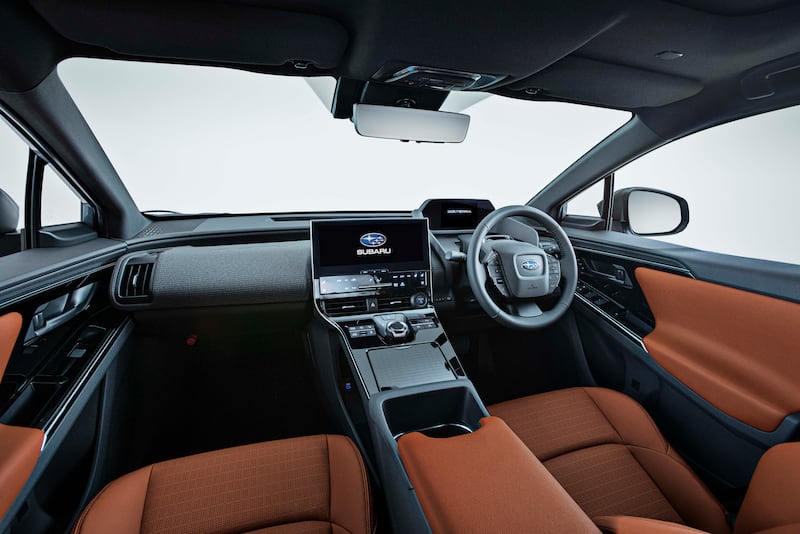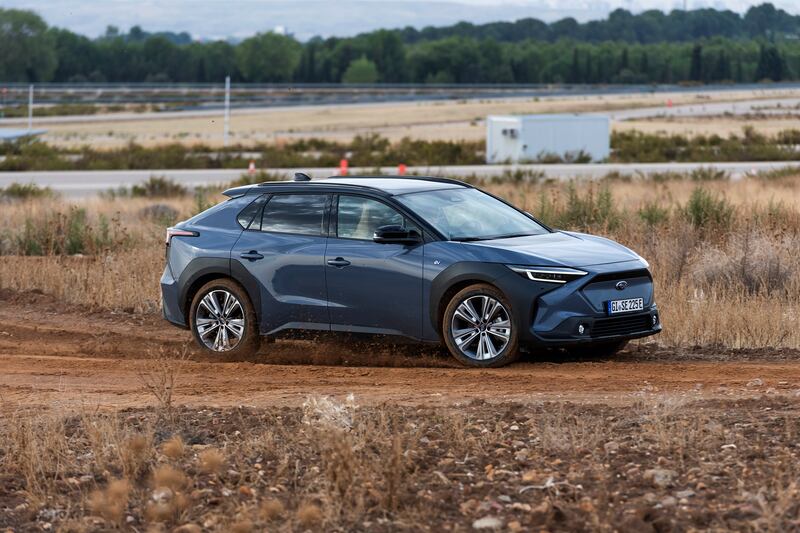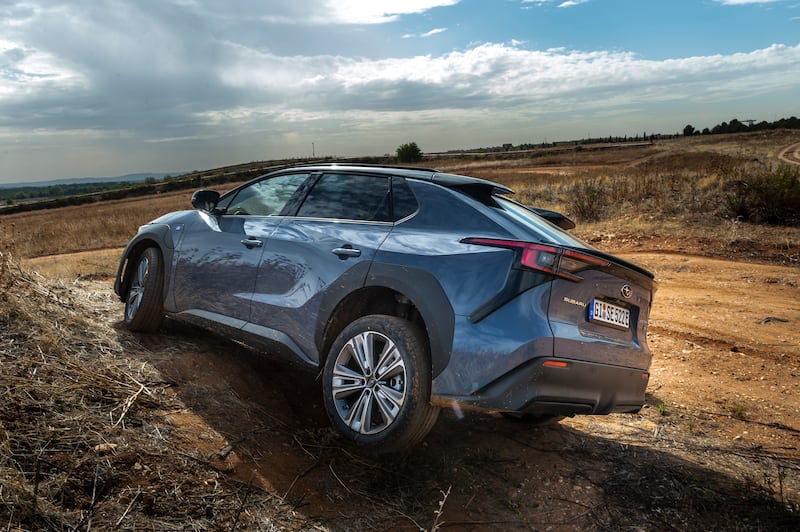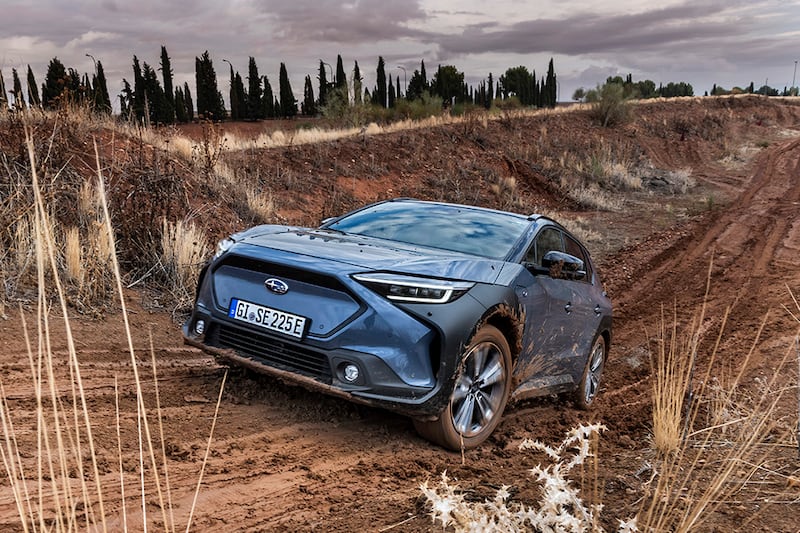It says something about Toyota’s lethargic attitude to full-electric cars that it has launched its first EV alongside the relatively niche brand of Subaru. With the carmakers already involved in technical partnerships, the deal for the creation of this EV crossover would seem to be one that flowered best for Subaru.
After all, if you are going to partner with someone else to overcome the difficult hurdles in building your first EV, why not do so with the world’s biggest carmaker. The plan was eminently sensible: Toyota provides the platform and electric motors, given its years of working with hybrid powertrains. Subaru would bring to the table its acumen for rough and tumble four-wheel drive family cars.
The only problem was the wheels came off. Literally. What was meant to be a much-lauded fanfare arrival of Toyota to the full EV market was overshadowed by a recall within weeks of launch when engineers noted that sudden braking could cause a wheel hub bolt to detach. The problem has been solved, but it detracted from what should have been a landmark moment for Toyota and the EV market.
At Subaru, the fact that most in the mainstream haven’t heard from the brand for years has proved something of a positive. It was Toyota who made the headlines over the recall.
How the death of an ‘old boy from Ireland’ in London-Irish suburb sparked a misguided viral appeal
As an Irish person in Australia there is one question I’m always asked
Charli XCX live review: Pop star fails to become queen of Malahide Castle as she brings Brat to Dublin
I Am Not an Alcoholic: Camaraderie was coming out of the cracks in the walls
Subaru is one of the brands for which most car fans harbour a soft spot. The association is either with mad-cap rally cars or unbreakable off-roaders. Either way, it is held in the sort of esteem most other brands envy. Sturdy is the word we normally associate with Subaru.
[ Updated MG 5 estate remains practical but flawedOpens in new window ]
The problem for Ireland – and Europe – is that the Japanese brand’s focus has been on the US market. Therefore, its engine line-up wasn’t suited to European tastes or taxes. Ardent fans – particularly the likes of vets who sought a rough-and-tumble family car – frequently bit the bullet and shelled out for Subarus even if it didn’t seem to make financial sense. Now that’s the sort of loyalty you can’t buy.
Now comes an EV that should greatly widen the brand’s appeal. But does it live up to Subaru’s much-admired DNA? Or is it more rebadged Toyota?
By opting for a two-motor set-up (one on each axle), Subaru’s four-wheel drive ethos is intact. The system that runs it, X-Mode, is also a Subaru innovation, controlling the motors and brakes to deliver the best traction on varied terrain.
The styling is largely down to Toyota, the Solterra being virtually identical to the bZ4X in everything but its badging. It looks smart, if lacking the quirky oddity that Subaru often brought to the market.


Inside and it’s much the same as Toyota, with an impressive big centre console screen that’s smart and easy to use, combined with plenty of sturdy plastics that should stand the test of time. As with most EVs where the battery is stored under a long flat floor plan, legroom is ample, but height is an issue, forcing the rear passengers to sit with their knees quite high. The boot isn’t class leading at 441 litres, but there are enough stowage cubbyholes for family life.
If the bulky looks don’t dissuade you from thinking this might be an EV Impreza, the fact it weighs in at more than two tonnes should certainly put that idea to rest. All that weight also impacts on the car’s handling. It’s calm and composed, with a supple ride, but it never really makes the leap into excitement or entertaining, unless you challenge it in the dirt.


There, the X-Mode set-up, which comes as standard, showcases features such as “Grip Control”, where the car manages its own acceleration and braking on rough terrain or steep inclines. It offers the sort of reassuring prowess that gives you confidence to cross the muddy field or tackle the snow-covered back road.
Range is one of the Solterra’s weak points, which is a pity given that Toyota did the work on the battery and, as a result, should be ahead of the rest of the pack. Claiming 465km on a single charge, it’s on a par with the rest of the market, and a figure we couldn’t match during our time testing the car. Toyota has been coy about stating the usable capacity of its battery pack, but some estimates put it close to 65kWh, which is less than others on the market. The official total capacity is 71.4kWh, which even then is less than some similarly-sized (and priced) rivals.
The clearest sign that engineers opted for comfort over agility is in the power delivery. A 0-100km/h time of 6.9 seconds is quick, but it arrives without any drama.
[ Mercedes EQS SUV review: A long-range, seven-seater EV with a limo interiorOpens in new window ]
Straight-line speed, of course, is over-rated, particularly in EVs. It’s in the bends that you can really test these cars’ engineering prowess. The Solterra doesn’t roll or wallow, but it does feel bulky and less engaging than we’ve come to expect from this brand.
In comparison to rivals like the Ford Mustang, it feels more sedate.
Other rivals include the VW ID.4, Skoda Enyaq, Tesla Model Y and Hyundai Ioniq 5 to name but four. As you can see, while there is a shortage of EVs in many market segments, others are getting overcrowded. This is the sweet spot for delivery cash to carmakers and for those of us who like the brand, it’s nice to see Subaru in the mix. And with a price starting at €51,495, it’s competitive.

The car itself doesn’t do enough to stand out from the crowd, however. Even with its X-Mode set-up, it doesn’t evoke the sort of sturdy mechanical engineering that you felt through the steering wheel and chassis of a Subaru.
The electronics are in the driving seat and that makes the Solterra a similar offering to rivals that don’t carry the same off-road kudos. There has always been something quirky, a little left field about Subaru that let it breach the usual barriers between premium and mainstream.
It’s great to see it running with the big brands, but by partnering with Toyota, it has perhaps become a little too middle of the road and mainstream than we might have liked.
Subaru Solterra: the lowdown
- Power: Two electric motors powered by a 71.4kWh battery pack and putting out a combined 215bhp
- 0-100km/h: 6.9 seconds
- Range: 465km (claimed)
- Price: €51,495
- Verdict: Great to have the brand in the race, but it needs to dial up the quirky charm















